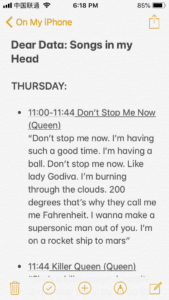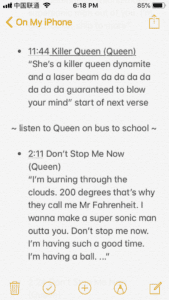For this week’s project, I mapped out the songs that got stuck in my head.
I kept a list on my phone’s Note app. I noted the time, the song, the artist, and sometimes the repeated phrases. I realized through this project that when I have a song stuck in my head, I don’t sing the entire song, I sing a section (usually the chorus). Sometimes I would have the chorus running in my head over and over for about an hour.
Some of my notes:


For my visualization, I made circles for each song. The size corresponds to how many times it entered my head. I accidentally made my circle for 2 times just as big as the circle for 5 times. Each song is color-coded and has an arrow going to the next song that popped up. The starting line has the day of the week. There are also time stamps. There is a little headphone icon that is placed in certain areas, noting that I listened to music in between the songs stuck in my head. For example, I had “Don’t Stop Me Now” stuck in my head, then I got on the bus, listened to music, got to school, stopped my music, then “Killer Queen” was stuck in my head.
One issue I ran into was whenever I went to log my song, I would see the ones I’ve logged before, then start singing them. I would then try to do an activity that would get it out of my head to get back to an “organic” manifestation of a song getting stuck in my head. I also noticed that sometimes my lyrics weren’t right, so it forced me to really think about that. In one instance, I was meshing two songs together so that was something interesting to note.